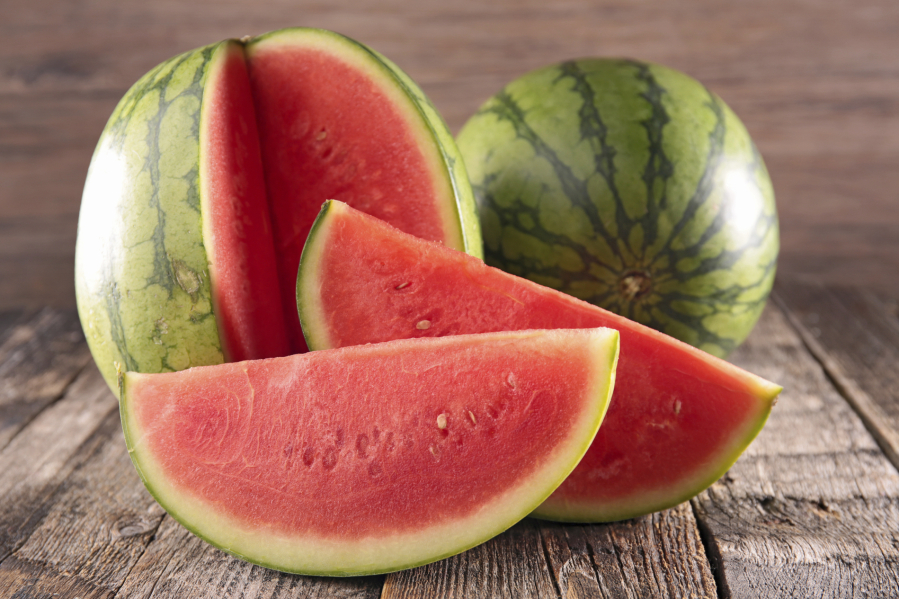July is National Watermelon Month, not only because a cool, refreshing slice of watermelon represents the best of summer, but also because watermelon harvests peak this month.
There are 600 to 1,200 varieties of watermelon grown worldwide, and more than 300 varieties grow in the United States. Because there are so many varieties, they are often grouped according to characteristics, such as shape, rind color/pattern and size.
The most common watermelons available are:
• Seeded: The classic watermelon comes in a wide range of sizes weighing 15 to 45 pounds They are usually round, long, or oblong.
• Seedless: Up to 85 percent of all watermelons produced in the U.S. are estimated to be seedless. They weigh 10 to 25 pounds and are round to oblong. They are not the result of genetic engineering, but rather hybridization — the crossing of two different types of watermelons. Seedless watermelons will appear to contain some white seeds, which are only empty seed coats.
• Mini: Petite “personal watermelons” are easy to handle, and their thinner rinds can mean more flesh per pound. They are very round and weigh 1 to 7 pounds
• Yellow and orange: These watermelons are generally sweeter than red-fleshed watermelon. They weigh 10 to 30 pounds and are round.
Watermelon has been traced back southern Africa, where it still grows wild today. The ancestor of the modern watermelon is a tough, drought-tolerant plant prized for its ability to store water for tribes crossing the deserts. Watermelon is related to cucumbers, pumpkins and squash. The record for the heaviest watermelon, grown in Arkansas in 2005, is 268 pounds.
To thump or not to thump? Experts who recommend thumping seem to agree that a fully ripened watermelon will have a deeper, hollow “bass” sound. Others suggest looking for a firm, symmetrical melon, free from bruises, cuts or dents. The watermelon should be heavy for its size. The underside of the watermelon should have a creamy yellow (not green) spot from where it sat on the ground and ripened in the sun. If you are purchasing a pre-cut watermelon, choose the flesh that is deepest in color and lacks any white streaking and has been kept in ice or refrigerated. If the watermelon is seeded, the seeds should also be deep in color, or white.
Uncut watermelons are best stored at room temperatures. Once washed and cut, watermelon should be well wrapped in cling film or cut up and stored in sealed containers in the refrigerator to preserve freshness, taste, and juiciness.
Many people prefer to enjoy the juicy flesh of the watermelon fresh, but the seeds are also edible and nutrient-rich. To roast melon seeds, rinse, drain and pat dry. Toss the seeds with olive oil, salt, or other seasonings, spread them in a single layer on a baking sheet and roast at 325 degrees for 20-40 minutes.
The rind of watermelon can be marinated, pickled or candied.
Slices of watermelon grill nicely. To grill slices, brush the watermelon lightly on both sides with olive oil and grill over high heat until grill marks have formed and the melon is slightly softened, about 5 minutes. Remove it from the grill and sprinkle with sea salt and a little fresh ground pepper.
Puree watermelon, cantaloupe and kiwi together and swirl in a little plain yogurt to serve as a refreshing cold soup. Toss a few juicy chunks of watermelon with greens and goat cheese for a refreshing salad. Liven up a summer barbecue by serving watermelon salsa made with jalape?os and chopped onions, watermelon cocktails or grilled slices for dessert. You can even bake a watermelon pie like the Greeks enjoy!
For additional recipes and serving suggestions, check out Chef Scotty’s Market Fresh Recipes at http://ext100.wsu.edu/clark/?p=8163.
Judi Seifert is a Clark County WSU Extension Master Food Preserver. For additional recipes, food preservation and food safety information visit http://ext100.wsu.edu/clark/?p=1134. Have questions? Call MFP Helpline: 360-397-6060 ext. 5366, or join Facebook Discussion Group “WSU Home Food Preservers – Clark County.”



